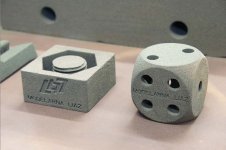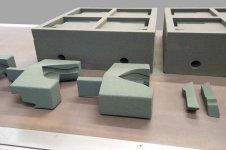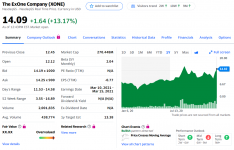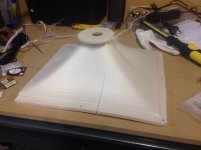Basically, yes, to get what you want.
- Does anyone have an experience with rough waveguide surface? There's a company here able to 3D print from (resin-impregnated) sand. They use a hi-tech professional equipment mainly for mold printing. I'm seriously considering trying it out (15" WG for about 200 EUR/piece). Of course they could also cast from aluminum right away (~600 EUR/piece).
- Does anyone have an experience with rough waveguide surface? There's a company here able to 3D print from (resin-impregnated) sand. They use a hi-tech professional equipment mainly for mold printing. I'm seriously considering trying it out (15" WG for about 200 EUR/piece). Of course they could also cast from aluminum right away (~600 EUR/piece).
Attachments
Prices seem fair. How about multi price? Thinking group buy here... Shipping costs?
If one paint that and sand it down where the sand starts to show... should give a smooth surface. And yes, surface finish vs. sound? Really, isn't that "imagined"?
//
If one paint that and sand it down where the sand starts to show... should give a smooth surface. And yes, surface finish vs. sound? Really, isn't that "imagined"?
//
Last edited:
I'm quite certain that this is achievable. What is your definition of a low crossover?What I always wanted was a narrow CD. Less than 50 degrees before dropping 6db+.
50 degrees is really quite a wide area when it's drawn out in my living room, and would cover several seats, but this would also:
-Keep efficiency high (smaller radiating area)
- Allow reflections to have the same spectrum to on axis, but at a much reduced level making imaging excellent for the direction of voices.
Alas, such a horn in 1.5 inch with a low crossover is unicorn poo.
Here is results from my simulation of a 320x198 mm horn I intend to 3D-print for a 2" fullrange driver (Peerless 830970):
The lines are spaces with 7.5 degrees. So at 2 kHz -6 dB is at about 34 degrees and at 5 kHz it's at about 28 degrees (both with 15-degree as reference).
/Anton
By simply measuring in the image. Not very exact, but sufficiently so.
Red is on axis, green is 15 degree and black is 30 degree.
/Anton
Red is on axis, green is 15 degree and black is 30 degree.
/Anton
Do they give any strength values for that material? Seems like it could be somewhat weak and brittle.Basically, yes, to get what you want.
- Does anyone have an experience with rough waveguide surface? There's a company here able to 3D print from (resin-impregnated) sand. They use a hi-tech professional equipment mainly for mold printing. I'm seriously considering trying it out (15" WG for about 200 EUR/piece). Of course they could also cast from aluminum right away (~600 EUR/piece).
Flexural strength of sand 180-22 N / cm 2
Breathability 180-300 GP (normal breathability unit) resp. 300-500 SI
?
Google Translate
//
Breathability 180-300 GP (normal breathability unit) resp. 300-500 SI
?
Google Translate
//
That's for a raw print alone, i.e. for molds. I guess that the epoxy resin impregnation (not a standard treatment) makes it pretty strong - "as a stone", they say.
Some more photos:
Some more photos:
An externally hosted image should be here but it was not working when we last tested it.
An externally hosted image should be here but it was not working when we last tested it.
An externally hosted image should be here but it was not working when we last tested it.
Last edited:
This looks very promising and price competitive with other construction methods for large waveguides. Whats the actual machine like that makes these? some kind of 3d printer? Can this also be used to directly make a unity horn from a 3d model? maximum dimension of 1800 x 1000 x 700 mm is huge!
It's most probably this one (S-Max): ExOne | Sand 3D Printers – Sand Printing & Casting
They print directly from 3D CAD data and I guess it's able to print just about anything.
Video: ExOne 3D Core & Mold Printing - YouTube
They print directly from 3D CAD data and I guess it's able to print just about anything.
Video: ExOne 3D Core & Mold Printing - YouTube
Last edited:
I found an interesting video about an artist turning plaster.
Could be a good inspiration perhaps, what there is missing is of course a laser cut steel template/tool.
Tournage d'un bol en plâtre - Plaster Bowl Turning. - YouTube
Could be a good inspiration perhaps, what there is missing is of course a laser cut steel template/tool.
Tournage d'un bol en plâtre - Plaster Bowl Turning. - YouTube
I'm contemplating about getting a BIG 3D printer capable of over 1m3 prints. Would there be takers for big horns and such if I offered to print them at reasonable rates? They won't be "free" but should be affordable in price. Especially if making multiples of same horn for several people.
I have large printer 1x1x0,5m (3DP1000) with pellet extruder. Useless because material deforms, shrink. You need an oven. If you print slow with <0,8mm nozzle than chances are bigger. If I find suitable material will let you know.
Last edited:
I'm contemplating about getting a BIG 3D printer capable of over 1m3 prints. Would there be takers for big horns and such if I offered to print them at reasonable rates? They won't be "free" but should be affordable in price. Especially if making multiples of same horn for several people.
My experience has been exactly the same as Jack.
In fact, after I upgraded to a large printer, I went out and bought another small printer. Because maintaining the temperature in the printing enclosure is so critical, and if the temperature varies, your print suffers significantly.
Big printers may be practical if you have the room and expertise to build an enclosure that can maintain temperature really evenly.
A friend of mine commandeered a bathroom for his giant 3D printer. I thought that was clever; it's a small space so it's relatively easy to keep an even temperature.
I'm quite certain that this is achievable. What is your definition of a low crossover?
Here is results from my simulation of a 320x198 mm horn I intend to 3D-print for a 2" fullrange driver (Peerless 830970):
The lines are spaces with 7.5 degrees. So at 2 kHz -6 dB is at about 34 degrees and at 5 kHz it's at about 28 degrees (both with 15-degree as reference).
/Anton
Interesting!
Do you have a spectrogram for this? I find it easier to evaluate relative performance on them.
I'm currently using a big JMLC 350hz horn that is just magical because (I think?) The DI is low. Listening to Bille Eilish whispering puts the hairs up on the back of your neck, and big scale orchestra is just more exciting than on other speakers.
But it beams so much at the top that it's frustrating to live with in an open plan house as I walk around.
I wonder if I can narrow the directivity of the bass driver to blend will a more constant directivity narrow horn rather than one that goes from wide at 500hz to narrow at 20khz
Low crossover for me would be 500hz. 1.5 inch throat driver 0deg exit angle. In my application I can go max 900mm wide (or so), depth about the same, bit less depth is better.
I can print any size really as I run a print farm.
Last edited:
- Home
- Loudspeakers
- Multi-Way
- Acoustic Horn Design – The Easy Way (Ath4)



